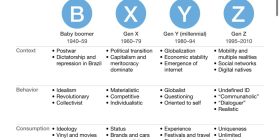People Pillar
The People Pillar is among four of the pillars that encompasses the Fashion Business School. It represents consumers but also stakeholders of a brand who can cater to their target market’s needs. The emphasis of the people Pillar is on how fashion adapts itself in this evolving world which is heavily influenced by Generation Z.
The relationship between the industry and people is crucial for success and the aim to remain relevant, which can be achieved by adopting the generation’s values in brands’ operations/practices (ethics, diversity, and inclusivity). The industry targets them specifically through meticulous marketing strategies as well as incorporating Corporate Social Responsibility. A 2021 survey conducted by a market researcher Forrester, shows 51% of Gen Z consumers in the US will research companies’ practices ensuring CSR before purchasing (Tait, 2023). Gen Z is the second youngest generation with individuals born between 1996-2010 (McKinsey, 2023). They are hyper aware of social, environmental, and economic issues which impact their consumption and behavioral patterns. Generally, they are inclined to help stop the deterioration of the climate situation, they demand accountability and action, and strongly believe in providing opportunities for marginalized communities (McKinsey, 2023).
For a brand to attract consumers, they must have a solid story or purpose and be committed to reversing their unsustainable fashion practices. They must communicate these aspects of their brand through social media to reach the target market where they are more likely to be influenced. Most Gen Z Asian consumers rely on the internet to make informed decisions about products. Similarly, 40% percent of Gen Z consumers in the US are influenced by online brands (Mckinsey, 2023). Digitization is key for a brand to introduce their products to this generation as they are referred to as ‘digital natives,’ according to a McKinsey article. A strong online presence, CSR incorporated in daily operations, and diversity represented (distinct ethnicities, races, body shapes and sizes, etc.) in a brand is what lures Gen Z consumers. A prime example of this is Savage X Fenty, who makes it their mission to include every individual and display their uniqueness. Rihanna’s, the artist, tagline in her Savage X Fenty Show “You are invited to a show made to celebrate everybody” suggests inclusivity (Lian and Gwynne, 2022). The brand has successfully regarded Gen Z’s priorities when it comes to fashion consumption. Their lingerie flaunts and complements all body types, and the makeup line represents all races through various shades available (McConnell, 2019).
Reference list
Lian, J. and Gwynne, J. (2022). What Does It Take to Be ‘Savage’?: Diversity, Empowerment and Representation in Rihanna’s Savage × Fenty Fashion Show. Palgrave Studies in (Re)Presenting Gender, [online] pp.99–113. doi:https://doi.org/10.1007/978-3-030-99154-8_6.
McConnell, G.G.H., Leanne Italie, Glenn (2019). ‘God Gifted genius’: Rihanna Heaps Praise on Parris Goebel after Fashion Show Success. [online] Stuff. Available at: https://www.stuff.co.nz/life-style/fashion/115982662/god-gifted-genius-rihanna-heaps-praise-on-parris-goebel-after-fashion-show-success [Accessed 15 Oct. 2023].
McKinsey (2023). What is Gen Z? | McKinsey. [online] www.mckinsey.com. Available at: https://www.mckinsey.com/featured-insights/mckinsey-explainers/what-is-gen-z.
Tait, A. (2023). Meet the Gen Z Brand whisperers: ‘I Come in and I’m like: Don’t Make Some Weird old-ass campaign!’ The Guardian. [online] 22 Apr. Available at: https://www.theguardian.com/lifeandstyle/2023/apr/22/meet-the-gen-z-brand-whisperers-weird-old-ass-campaign.
Image:
Nast, C. (2022). An Exclusive Look At Rihanna’s Savage X Fenty Show Volume 4. [online] British Vogue. Available at: https://www.vogue.co.uk/fashion/article/rihanna-savage-x-fenty-show-volume-4.




